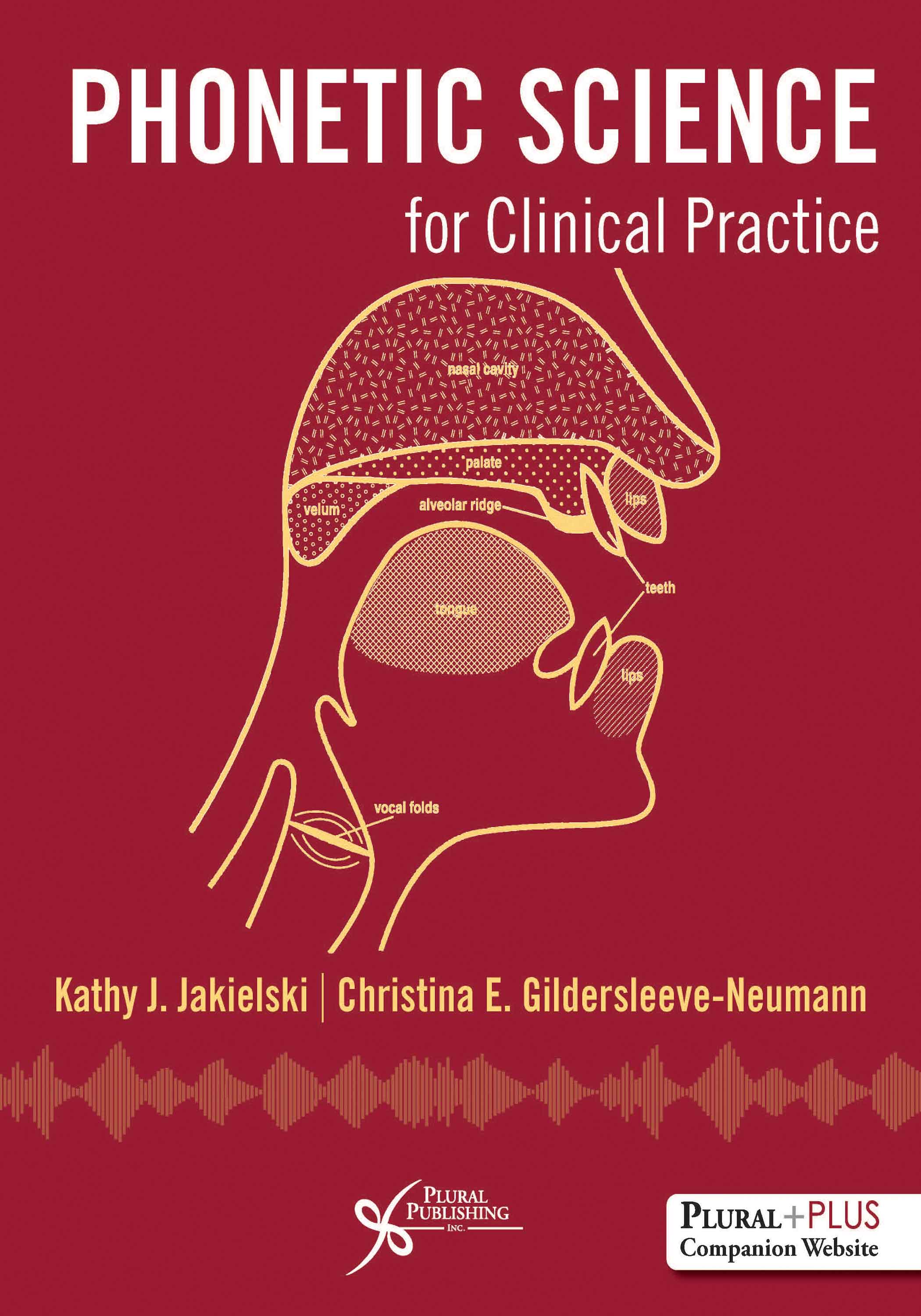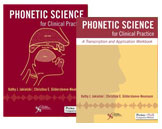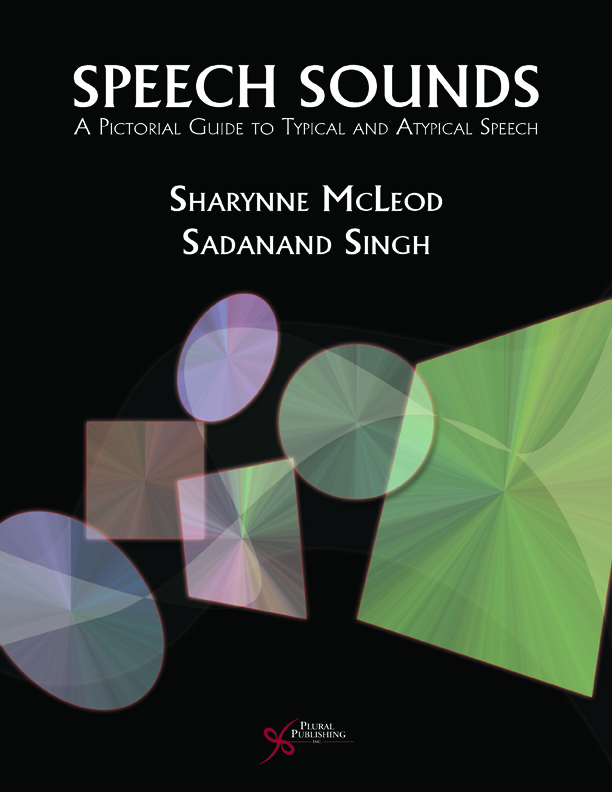
Phonetic Science for Clinical Practice.
First Edition
Kathy J. Jakielski, Christina Gildersleeve-Neumann
Details: 330 pages, 2-Color, Hardcover, 8.5" x 11"
ISBN13: 978-1-59756-731-2
© 2018 | Available
Phonetic Science for Clinical Practice is designed to serve as an introductory, one-term textbook for undergraduate phonetics courses in communication sciences and disorders. The text begins by introducing the fundamental tool of transcription - the International Phonetic Alphabet - while also presenting the science underlying that set of symbols. The goal of this text is to teach students how to think about the data being transcribed - in other words, how to think like a phonetician.
Every chapter begins with Learning Objectives and an Applied Science problem and question - a research- or clinical-based question that can be answered by applying the phonetic science concepts covered in that chapter. By the end of the chapter, students will revisit the question and be asked to solve the problem posed. Students studying communication sciences and disorders and practicing speech-language pathologists or audiologists will be more successful in their clinical work if they understand the science that underlies the tool of transcription. In each chapter there are also several diverse clinical examples to review the application of concepts covered.
Phonetic Science for Clinical Practice covers exactly what students (and clinical speech-language pathologists and audiologists) need to know to be effective speech-language pathologists and audiologists in any setting where an understanding of speech sounds is needed.
Key Features
- Focused on practical, clinical application, and the information needed for clinical practice
- Did You Get It? comprehension checks on the material throughout each chapter
- Flashcards for phonetic transcription practice
- A PluralPlus companion website that features PowerPoint lecture slides, chapter reviews, sound files for IPA symbols and particular words, as well as related resources, glossary flashcards, mnemonic flashcards, and printable study aids
From the Foreword
"In this book and workbook, Kathy Jakielski and Christina Gildersleeve-Neumann have taken a different approach that will make the material both easier to digest and more engaging to our students. They present articulatory phonetics firstthe anatomical and physiological foundations for consonants, vowels, and diacritics—as the basis for a chapter dedicated to each of these. Chapters on prosody and then acoustics come next. Only once students have a solid foundation in these more basic concepts about speech do the authors focus on concepts from phonology-phonemes, allophones, etc. Finally, they close with a lively review of the many respects in which languages differ from each other phonetically. Thus, students will be able to process and master the various components of the field of phonetics one by one. As the reader progresses through the book, the material from the earlier chapters is reviewed and related to the new concepts. As a result, there are many opportunities to re-visit ideas from more basic aspects of phonetics and to integrate them into more complex concepts for a deeper understanding of the whole. This organization should be far less intimidating and far more reinforcing for students. Another innovation in this book is that each chapter includes frequent "Did you get it?" reviews, which encourage the student to answer a small number of short answer or multiple-choice questions that reinforce the material just covered. These, in addition to the excellent, varied exercises in the accompanying workbook and also the mnemonic flashcards that are included, give the students many engaging opportunities to interact with the material and thus to master it at a far deeper level than they would by merely reading the text. The organization of the material is definitely not the only innovative aspect of this book-workbook set. Most motivating for the students are the "Applied Science" sections that begin and end each chapter. Some are fascinating phonetic puzzles that will increase the students' curiosity about the topic of the chapter from the get-go. Others are clinical mini-case studies that raise interesting questions, the answers to which depend upon the material in that chapter. These are not trivial; they involve key clinical issues, such as identifying covert contrasts (Chapter 4), detecting production-based versus perception-based speech errors (Chapter 6), and differentiating the impacts of bilingualism from speech disorder (Chapters 7, 8, and 9). Despite the basic level of understanding that the undergraduate readers will have, the authors have managed to include accessible real-life clinical conundrums with "Aha!" solutions, based upon the recently-learned material, revealed at the end of the chapter. The clinical case studies are only one of the means by which Jakielski and Gildersleeve-Neumann introduce intriguing information about languages other than English into the text. Throughout the book, especially in Chapter 9, they provide fascinating phonetic details, not just about Spanish, German, and Chinese but also about Guarani, Navajo, Quichua, Xhosa, Tlingit, and Taa, to mention just a few. Students completing a course taught with this textbook should have a much wider appreciation of phonetics as a human trait, well beyond the speech sounds of English. Don't be misled by the comfortable conversational style in which this book is written. These two authors "know their stuff"; both have many years of hands-on experience in clinical phonetics as well as in teaching this subject. The information in the book, for all of the aspects of phonetics that are covered, is solid as well as accessible.
—Shelley L. Velleman, PhD, CCC-SLP, Chair & Professor Communication Sciences and Disorders, University of Vermont
Reviews
"I love the applied component of each chapter and the exercises/activities to help put theory into practice. The visuals of pairing the vowels with a picture is genius!"
—Joy McKenzie, MS, CCC-SLP, Assistant Professor, Department of Communication Sciences and Disorders, St. Cloud State University
"The organization of this textbook is one of its major strengths. The authors did a tremendous job presenting the appropriate amount of information in a straight-forward way. The writing construction is clear, but very accessible to the novice and enticing to the expert. One example of the way that the authors make this such a clear, but enjoyable text is the "Did You Get It?" review sections.The authors do a great job catching the audience's attention by introducing interesting facts. I commend the authors for presenting potentially challenging and complex information in a clear and engaging manner. I was not sure what could be done to improve upon the existing textbooks for clinical phonetics. However, it is clear that the authors have identified a gap in this arena based upon clinical and academic experience.
—Heather L. Rusiewicz, PhD, CCC-SLP, Assistant Professor, Department of Speech-Language Pathology, Duquesne University
"I am really excited about this book. The material is presented in a very coherent manner. There is more phonetic detail (related to acoustic and linguistic phonetics) that provides the reader with a more comprehensive view of phonetics than other introductory materials that are available."
—Heather L. Ramsdell-Hudock, PhD, CCC-SLP, Assistant Professor, Department of Communication Sciences and Disorders, Idaho State University
"This text provides a much-needed look at phonetic science with a focus on the articulatory bases of speech. It values a multicultural perspective on speech production, while maintaining strong coverage of the basic phonetics and phonological structures relevant to General American English. The accompanying workbook is comprehensive, with many exercises having easy, intermediate, and challenging examples, and with most chapters containing a blend of clear right/wrong answers and generative questions which must be answered by the student creating their own response, in which case there may be many potentially correct answers. While written for an audience that is new to phonetics, it does not avoid many of the complexities inherent to the topic, including inter-personal differences in articulation, dialectical variability, and descriptions of non-English speech sounds that will be unfamiliar to most English speakers. Jakielski & Gildersleeve-Neumann's text and workbook show excellent promise as a leading candidate for a new set of core materials in the training of speech-language pathologists."
—Andy McMillin, MA, CCC-SLP, Clinical Associate Professor, Department of Speech and Hearing Sciences, Portland State University
Preface
Reviewers
How to Use This Book
Foreword
Chapter 1. Introduction to Phonetic Science
Chapter 2. Articulatory Phonetics of Consonants
Chapter 3. Articulatory Phonetics of Vowels
Chapter 4. Broad and Narrow Phonetic Transcription
Chapter 5. Suprasegmental Features of Speech
Chapter 6. Acoustic Phonetics
Chapter 7. Linguistic Phonetics and Phonology of Consonants
Chapter 8. Linguistic Phonetics and Phonology of Vowels
Chapter 9. Beyond General American English: Speech Possibilities Within and Across Languages
Glossary
Mnemonic Flashcards
Index

Phonetic Science for Clinical Practice Bundle (Textbook and Workbook).
This bundle includes the ''Phonetic Science for Clinical Practice" textbook and workbook, and is designed to serve as an introductory, one-term resource for undergraduate phonetics courses in communication sciences and disorders.
The textbook begins by introducing the fundamental tool of transcription-the International Phonetic Alphabet-while also presenting the science underlying that set of symbols. The goal of this text is to teach students how to think about the data being transcribed-in other words, how to think like a phonetician.
Every chapter begins with Learning Objectives and an Applied Science problem and question-a research- or clinical-based question that can be answered by applying the phonetic science concepts covered in that chapter. By the end of the chapter, students will revisit the question and be asked to solve the problem posed. Students studying communication sciences and disorders and practicing speech-language pathologists or audiologists will be more successful in their clinical work if they understand the science that underlies the tool of transcription. In each chapter there are also several diverse clinical examples to review the application of concepts covered.
The workbook allows students to practice phonetic transcription and includes a variety of practice exercises such as fill-in-the-blank, short-answer, and multiple creative transcription activities. The questions are closely connected to the textbook, allowing students to review chapter material and quiz themselves in an efficient manner.
The Phonetic Science for Clinical Practice textbook and workbook cover exactly what students (and clinical speech-language pathologists and audiologists) need to know to be effective speech-language pathologists and audiologists in any setting where an understanding of speech sounds is needed.
Key Features
- Focused on practical, clinical application, and the information needed for clinical practice
- Did You Get It? comprehension checks on the material throughout each chapter
- Flashcards for phonetic transcription practice
- A PluralPlus companion website that features PowerPoint lecture slides, Chapter Reviews, sound files for IPA symbols and particular words, as well as related resources, glossary flashcards, and mnemonic flashcards
From the Foreword
"In this book and workbook, Kathy Jakielski and Christina Gildersleeve-Neumann have taken a different approach that will make the material both easier to digest and more engaging to our students. They present articulatory phonetics firstthe anatomical and physiological foundations for consonants, vowels, and diacritics—as the basis for a chapter dedicated to each of these. Chapters on prosody and then acoustics come next. Only once students have a solid foundation in these more basic concepts about speech do the authors focus on concepts from phonology-phonemes, allophones, etc. Finally, they close with a lively review of the many respects in which languages differ from each other phonetically. Thus, students will be able to process and master the various components of the field of phonetics one by one. As the reader progresses through the book, the material from the earlier chapters is reviewed and related to the new concepts. As a result, there are many opportunities to re-visit ideas from more basic aspects of phonetics and to integrate them into more complex concepts for a deeper understanding of the whole. This organization should be far less intimidating and far more reinforcing for students. Another innovation in this book is that each chapter includes frequent "Did you get it?" reviews, which encourage the student to answer a small number of short answer or multiple-choice questions that reinforce the material just covered. These, in addition to the excellent, varied exercises in the accompanying workbook and also the mnemonic flashcards that are included, give the students many engaging opportunities to interact with the material and thus to master it at a far deeper level than they would by merely reading the text. The organization of the material is definitely not the only innovative aspect of this book-workbook set. Most motivating for the students are the "Applied Science" sections that begin and end each chapter. Some are fascinating phonetic puzzles that will increase the students' curiosity about the topic of the chapter from the get-go. Others are clinical mini-case studies that raise interesting questions, the answers to which depend upon the material in that chapter. These are not trivial; they involve key clinical issues, such as identifying covert contrasts (Chapter 4), detecting production-based versus perception-based speech errors (Chapter 6), and differentiating the impacts of bilingualism from speech disorder (Chapters 7, 8, and 9). Despite the basic level of understanding that the undergraduate readers will have, the authors have managed to include accessible real-life clinical conundrums with "Aha!" solutions, based upon the recently-learned material, revealed at the end of the chapter. The clinical case studies are only one of the means by which Jakielski and Gildersleeve-Neumann introduce intriguing information about languages other than English into the text. Throughout the book, especially in Chapter 9, they provide fascinating phonetic details, not just about Spanish, German, and Chinese but also about Guarani, Navajo, Quichua, Xhosa, Tlingit, and Taa, to mention just a few. Students completing a course taught with this textbook should have a much wider appreciation of phonetics as a human trait, well beyond the speech sounds of English. Don't be misled by the comfortable conversational style in which this book is written. These two authors "know their stuff"; both have many years of hands-on experience in clinical phonetics as well as in teaching this subject. The information in the book, for all of the aspects of phonetics that are covered, is solid as well as accessible. —Shelley L. Velleman, PhD, CCC-SLP, Chair & Professor Communication Sciences and Disorders, University of Vermont
Purchasers of this book receive complimentary access to supplementary materials hosted on a PluralPlus companion website.
Instructor Materials:
- PowerPoint Lecture Slides
- Chapter Reviews
Student Materials:
- Audio Files
- Glossary Flashcards
- Mnemonic Flashcards
- Related Resources
- Printable Study Aids
To access the materials, log in to the website using the URL located inside the front cover of your copy of Phonetic Science for Clinical Practice.
STUDENTS:
To access the student materials, you must register on the companion website and log in using the access code located inside the front cover of your textbook.
INSTRUCTORS:
To access the instructor materials, you must contact Plural Publishing, Inc. to be verified as an instructor and receive your access code.
Email: instructormaterials@pluralpublishing.com
Tel: 866-758-7251 (toll free) or 858-492-1555

Speech Sounds: A Pictorial Guide to Typical and Atypical Speech
First Edition
Sharynne McLeod, Sadanand Singh
Details: 395 pages, B&W, Softcover, 8.5" x 11"
ISBN13: 978-1-59756-106-8
© 2009 | Available


